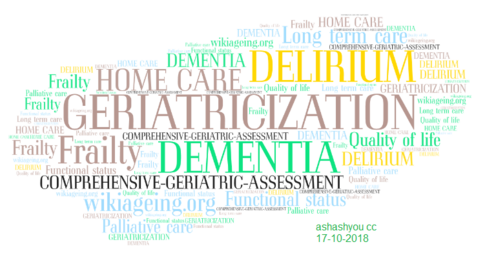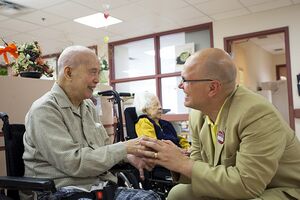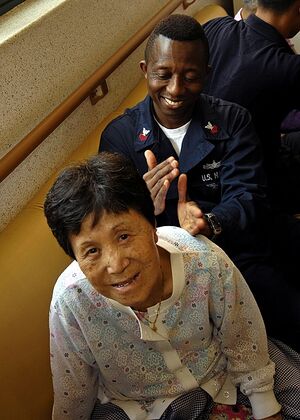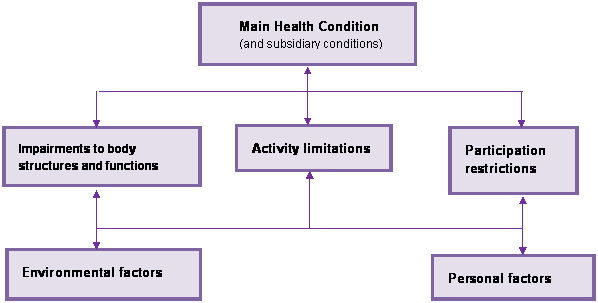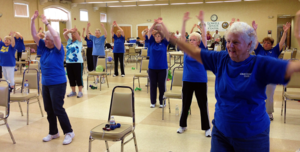Physiotherapy and Older People
Original Editor - Bhanu Ramaswamy as part of the AGILE Project.-
Top Contributors - Bhanu Ramaswamy, Admin, Kim Jackson, Lauren Lopez, Lucinda hampton, Shaimaa Eldib, Vidya Acharya, Tolulope Adeniji, Aminat Abolade and Evan Thomas
Introduction[edit | edit source]
There is reliable evidence for physiotherapy involvement for older people, especially those with falls, stroke, arthritis and frailty.
- There is strong evidence on the effectiveness of primary care/community-based falls prevention interventions for older people, eg. Otago Exercise Programme, with physiotherapy supervision. International evidence exists showing the benefit of exercise interventions for older people with frailty, which are primarily physiotherapy-led, or supervised.
- Physiotherapy is a core component of the comprehensive geriatric assessment (CGA), known to improve outcomes for older people, particularly those with frailty. A CGA approach is part of successful orthogeriatric care, and in the new area of perioperative surgical care for older people.
- Along with specialist elderly care wards, physiotherapists are core members of the stroke unit multidisciplinary team, providing therapy for patients on acute stroke units, stroke rehabilitation units and community stroke teams. Multidisciplinary stroke care has been seen to be very effective at improving outcome.[1]
The Fundamental Principles of Physiotherapy for Older People[edit | edit source]
| Disability is generally regarded as being due to a pathological process, or injury, not prima facie ‘old age’ |
| The effects of biological ageing reduce the efficiency of the body’s systems, but throughout life, optimum function is maintained in each individual by continuing to use these systems to their maximum capacity |
| Physiotherapists have a key role in enabling older people to use a number of the body’s systems fully to enhance mobility and independence |
| When neither improvement nor even maintenance of functional mobility is a reasonable goal, physiotherapists can contribute to helping older people to remain comfortable and pain-free |
| Prevention of the development of problems in later life through health promotion |
Physiotherapy Settings[edit | edit source]
In the UK, many initiatives have been set up to provide better systems of health and social services for older people. Most of these involve physiotherapy with the more common areas of work for physiotherapists with older people listed below:
- Health promotion and disability prevention programmes
- Hospital: either acutely ill on the general wards or on a specialised older person's unit, or specialised rehabilitation ward.
- Outpatient ambulatory clinics or day assessment and rehabilitation units: where individuals usually require input from more than one profession and spend a day in a centre where rehabilitation is provided.
Community:
- Community physiotherapy in a person’s own home or at a doctor's clinic. This could be provided by either a private physiotherapy company or by government-funded healthcare services.
- Regional and local outreach services, often for specific conditions. For example, a monitoring service for neurological or respiratory conditions with rapid response capabilities should the therapist detect a decline in the person’s condition.
- Intermediate care where care is jointly funded by health and social services. Such care is set up through a multidisciplinary team and runs for an average of two to six weeks to prevent (re)admission of older people into the hospital. This can take place either in the person’s own home or in beds set aside for rehabilitation at a residential care facility.
- Community rehabilitation teams with a longer time frame of up to 12 weeks. Historically such teams were funded to promote the early hospital discharge of people post-stroke, but who now take those with orthopaedic and general rehabilitation needs
- Physiotherapists in mental health teams, who can be called upon for specialist advice.
- In research institutes where research into age-related conditions and issues is conducted.
Essential skills for Geriatric Physiotherapist[edit | edit source]
Older adult care is complex because it comes with multiple conditions requiring knowledge of many specialties. Older adults often develop conditions under musculoskeletal, cardiovascular and neurological disorders.[2] There may be overlaps in these categories, as older adults often have multimorbidities. Due to the ageing effect on the health status of older adults and their disease pattern of presentation, it is advisable that physiotherapy in older adults should be trained in musculoskeletal, neurological and cardiovascular assessment and management of older adults. Essential skills for a physiotherapist specializing in geriatric care should, therefore, include full knowledge of physiotherapy practices in these three categories, focusing on the care of older adults.
Assessment[edit | edit source]
The assessments and principles of therapy with older people should follow suggested national protocols and guidance. The assessment of older people differs from that of younger people is in taking into account the differences in the body that occur with age.
There are different models of rehabilitation, the most universal and inclusive model is the World Health Organization's (WHO) International Classification of Functioning, Disability and Health[3]. Commonly known as the ICF, the framework offers a model whereby healthcare professionals can review multiple impairments and relate them to the relevant domains of an individual's life in order to guide assessment, goal setting and treatment planning.
Permission granted by WHO. Source: Short version booklet of the International Classification of Functioning, Independence and Health (WHO 2001) page 26. http://www.who.int/classifications/icf/en/; ISBN / WHO Reference Number 92 4 154544 5[edit | edit source]
The ICF is valuable to clinicians because it can guide a thorough assessment of the older person. The ICF helps clinicians assess impairments often impact on activities of daily living and how the person can participate in societal roles in later life[4]. The ICF also considers the person in context. For example, environmental factors (physical location and attitudes of society) and personal factors (medication factors, social supports). These can act either as barriers or facilitators in the analysis and the subsequent planning of appropriate nursing interventions and support. As a point of interest, many hospitals in the UK now use the related International Classification of Diseases & Related Health Problems (ICD-10) to code patients’ problems on admission, which compliments the ICF.
Medical History: Obtaining a thorough medical/surgical history and supporting drug history is of importance,
- In particular, medications can have a significant impact on the older adult and can contribute to poor mobility and falls. See Medication and Older People
- The individual might not report a significant medical condition (e.g. a cardiovascular condition)
Social History: Vital, older adult often rely on supports, either formal or informal (family and friends). For example, how can a physiotherapist (and other allied health disciplines ) guide rehabilitation in the case of the older person who is to be discharged home alone, but is unable to stand safely to cook a meal, or to walk to the shops to buy food.
The ICF can guide clinicians through assessment and act as a checklist to make sure all relevant history and assessment is included.
Treatment[edit | edit source]
The nature of physiotherapy means that assessment and treatment tend to focus on the physical nature of a person's condition. For older adults, the physical activities of daily life are an important starting point for treatments. Intervention should include (re)assessment of a person's abilities and difficulties in performing functional tasks such as transfers on/off a chair or the bed and general mobility.
Having assessed the older adult performing a task like chair transfers, the physiotherapist then identifies the underlying impairments impacting on the task. For example, strength and balance deficits, or psychological barriers such as a fear of falling. There are few techniques physiotherapists use that differ from those taught for all age groups, whether manual techniques are used in a clinic setting (although the mechanical changes to a person's skeleton may require us to modify a position of treatment) or functional intervention in the person's home.
Appropriate care must be taken with some treatment techniques, and more time allowed for the learning and practice of skills and exercises. For example, with an acute sprain, the history taking would be no different, but the treatment would take into account much more of the past medical history and pre-injury status. Treatment might still initially include rest, ice, compression, and elevation, but the therapist would also have to assess the condition of the skin to allow for the safe use of ice or the effects of compression. For example, if the treatment of ice, elevation and rest was for an already oedematous ankle, you must think about assessing the length of the hamstring muscles to make sure the person has sufficient length in them. This will confirm whether the patient can sit comfortably for the duration of the treatment with their hips flexed to 90 degrees or more.
Goals[edit | edit source]
Goals are important for keeping therapy person-centred and co-ordinating treatments.
- Goals should be directed more towards the management and improvement of a condition rather than passive ‘care’ towards the older person.
- At times, it is appropriate to work together with another team member whether in a hospital or community setting, not only to learn from one another but also to ensure you are working toward the same goals for the benefit of the individual[5].
Goals may be to improve the older person's function or to maintain the current function and prevent decline.
- The therapist must have knowledge of what is an acceptable ‘norm’ for this age group, e.g. age-related changes in a gait and posture.
- At times, there may be a conflict between the person's goals and the therapist's idea of what might be safe. The physiotherapist's task is then to highlight the risks and try to minimise them where possible rather than stopping a person functioning altogether.
Discharge Planning[edit | edit source]
Discharge planning requires considerable consideration and is an important element in preventing adverse events post discharge. Nearly 20 percent of patients experience an adverse event within 30 days of discharge. Research has shown that 75% of these could have been prevented or ameliorated.[6]See link for more
Outcome Measures[edit | edit source]
An outcome measure is a measure of change (usually from before to after an intervention). What is measured depends on your definition of ‘the outcome of interest’, on who wants the data and for what purpose. Physiotherapists may be interested in how a person’s function has changed; managers and purchasers in the cost of delivering this change; and the individual in how well they can function in everyday life.
See Category:Older People/Geriatrics - Outcome Measures
References[edit | edit source]
- ↑ BGS Physiotherapy and older people Available:https://www.bgs.org.uk/policy-and-media/physiotherapy-and-older-people (accessed 3.12.2022)
- ↑ Pasquetti P, Apicella L, Mangone G. Pathogenesis and treatment of falls in elderly. Clinical cases in mineral and bone metabolism. 2014 Sep;11(3):222.
- ↑ World Health Organisation. International Classification of Functioning, Disability and Health. Geneva: World Health Organisation, 2001.
- ↑ Izaks G, Westendorp R. Ill or just old? Towards a conceptual framework of the relation between ageing and disease. BMC Geriatr. 2003; 3(7). Accessed 30 August 2018.
- ↑ Squires A, Hastings M, editors. Rehabilitation of Older People: A handbook for the interdisciplinary team. 3rd ed. Cheltenham: Nelson Thornes 2000.
- ↑ Discharge Planning
